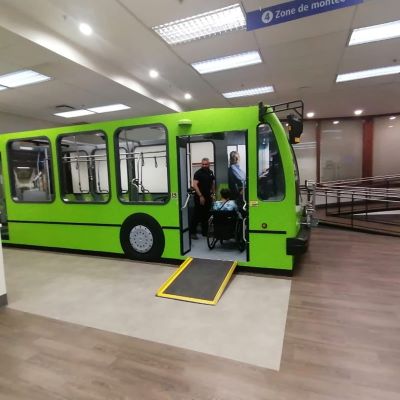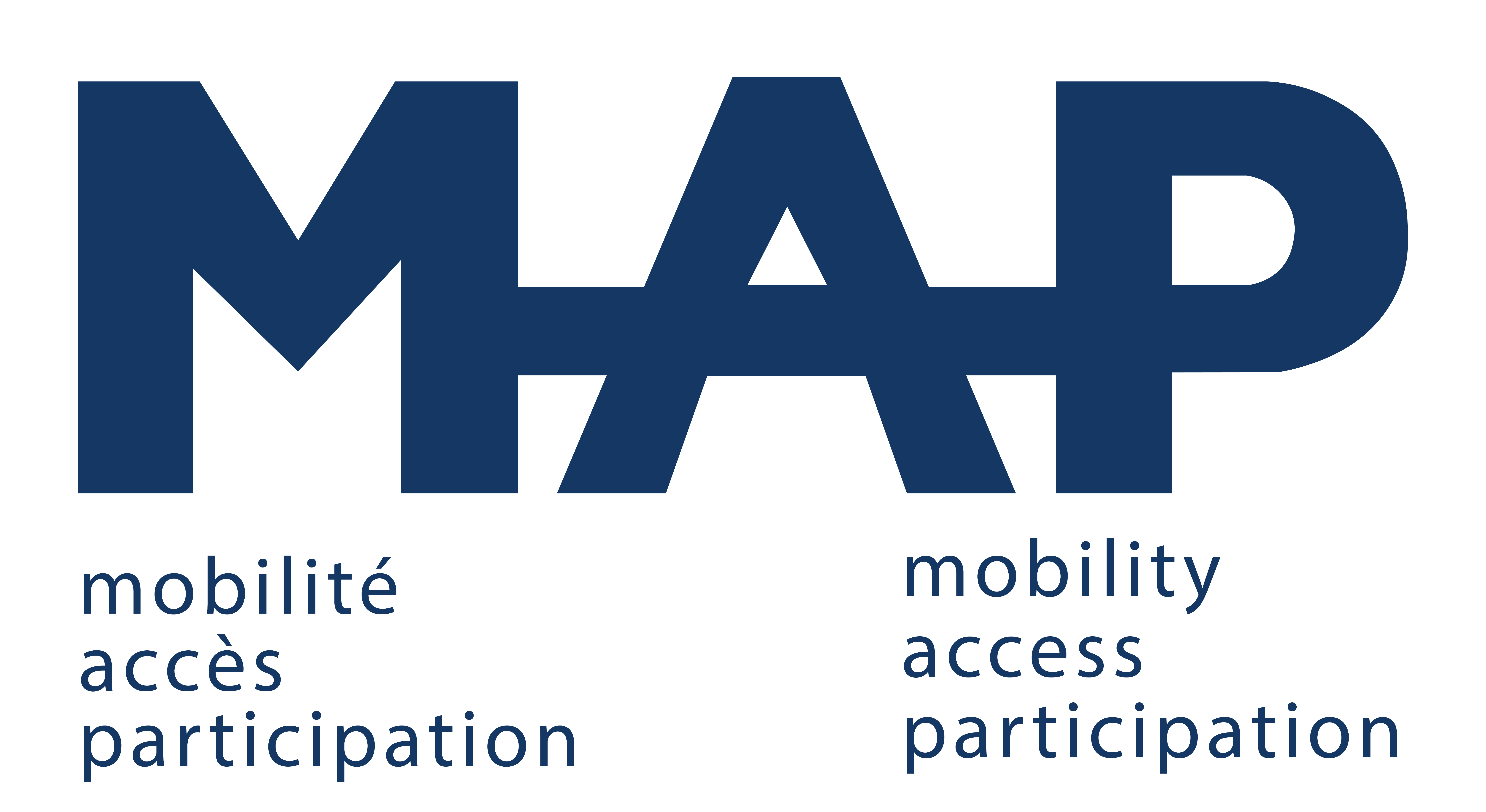
An accompaniment program can improve confidence and autonomy in the use of public transport by people with mobility limitations.
By Gbètogo Maxime KIKI
Public transit allows people to move easily and quickly from one place to another in their community. The bus is an ecological, economical and practical mode of transport compared to individual cars. It is all the more necessary when other means of transport are inaccessible or unavailable. It allows people to obtain the goods and services essential for their livelihood and to participate in physical and social activities. Using the bus offers many opportunities for people to get more involved in their communities. Indeed, thanks to buses, people can easily get around and discover their region’s different neighbourhoods and visit their friends and family. This allows them to participate in community activities, attend local events (museum visits, birthday parties, concerts, etc.), and meet new people. In addition, the bus promotes sustainable mobility by reducing traffic congestion and carbon emissions. By using the bus, people are helping to create more dynamic and interconnected communities where everyone can play an active role and fully engage.
People with mobility limitations are those who encounter difficulties or restrictions in their movement due to physical problems, such as injuries, physical disabilities, chronic diseases or health conditions that reduce their ability to move easily (walking, standing, climbing stairs or using buses). These individuals may need technical aids, such as wheelchairs, crutches or canes, and adaptations or support to independently access public spaces and services. People with mobility limitations frequently encounter obstacles to accessing buses. For example, they state that they do not use the bus because of difficulties associated with the buses themselves (getting on or off them; and even travelling on them is often difficult), a lack of knowledge and experience, as well as because of lived or perceived safety considerations (risk of falling, driver who starts or stops too fast)1,2. For these reasons, some people with mobility limitations prefer to stick to paratransit. However, several limitations have been reported with regard to the use of adapted transport. For example, paratransit does not allow flexible schedules and often requires a waiting time with significant delays. People need to plan trips several hours in advance (at least 5 hours) for an appointment of about thirty minutes, and the return trip is all the more important (about two hours of waiting)3,4. This can limit people’s freedom and autonomy and make it difficult, if not impossible, to plan spontaneous activities. The trips are sometimes cancelled or postponed causing frustrations for people who have commitments or prefer a faster and more reliable means of transport. Therefore, improving knowledge and skills in bus use can offer people with mobility limitations a more convenient mode of community transport, thus increasing their autonomy to get around.
In 2021, to facilitate the use of buses, the Capital’s Transport Network (RTC) created the integrated mobility support service (SAMI). The SAMI is a resource dedicated to improving user understanding and satisfaction with RTC services and possibly increasing the use of public transport services by people with mobility limitations5. It includes several services, one of which is a training program for the use of public transport. This program offers personalized and inclusive services allowing users to familiarize themselves with public and alternative modes of transport in a controlled place free of external stressors6. In short, the SAMI training program is a service that aims to help users better understand and use public transport to promote sustainable and convenient mobility 7.
The layout of the SAMI premises respects the principles of universal accessibility and brings together several RTC services. This includes an information centre for producing cards and selling tickets, a lost and found office and a training program for the use of public transport. On the premises, there is space to experiment with the self-service bike service (àVélo), a life-size model of a bus with an access ramp, a bus shelter with electric panels and an audible announcement, as well as a stop pole with a switch for visually impaired users. There are also computer stations to learn how to plan trips, etc. The bus’s interior is identical to that of a real bus, with space for people in wheelchairs and equipment accessible to all, such as lower stop buttons. The training program is offered free of charge and aims to be inclusive while being adapted to the needs and individual profile of each participant, whether they have mobility limitations or not. The training takes place in two phases, a theoretical phase followed by a simulated exercise phase in the large hall with the bus model and the bus shelter. At the end of the first session, each participant receives a personalized OPUS card with two tickets so that they can experience taking public transportation.
The research team sought to see the effects of the training program on people with mobility limitations; specifically looking at confidence, mobility in the community and satisfaction associated with the achievement of personal goals related to the bus. The team also wanted to summarize suggestions that could improve the program with the aim of making the use of buses easier for people with mobility limitations. Using several research approaches, the researchers selected twelve people with mobility limitations aged at least 30 years, residing in Quebec City and who were able to move with technical assistance or not. The participants were recruited where they could be found, i.e., brain injury associations, residences for older adults and by word of mouth (from one person to another). People included in the study were questioned up to two weeks before and after the training program using specialized measurement tools. After the training, we conducted interviews where we asked open-ended questions to understand the participants’ experience better and report on suggestions to improve the training program. The pilot phase of the study is now drawing to a close, and we are in the process of writing the manuscript.
The preliminary results can be summarized in three parts. First of all, the training program helped strengthen confidence, skills and autonomy in the use of buses. Although the increase in confidence to use buses and satisfaction with personal goals was not statistically significant, participants acknowledged that they acquired skills to use buses. The participants pointed out that they now have the confidence and feel autonomous in taking buses independently. For example, one participant, a 50-year-old man who occasionally used buses and had suffered a head injury and uses a walking stick, said of his classmates who felt confident taking the bus immediately after training: “Instead of using paratransit, they had taken two buses, they used it without having to wait an hour and a half, because paratransit is scheduled for an hour. ” (P2).
In addition, the results of the project have shown that the training program has contributed to helping the participants to carry out their daily tasks and their social commitments related to the use of buses. Although the increase in the mobility of participants was not statistically significant, it was sufficient to allow people with mobility limitations to expand their travel area and set several personal goals to achieve by using the buses, such as volunteering, attending choirs, running errands or visiting friends and family. Thus, after the training, the participants noticed an improvement in the performance of their daily activities and greater ease in assuming their social roles; one of the participants, a 71-year-old man who was not a bus user, had suffered several strokes and uses a walking stick as a technical aid, said: “I feel like going to the city for a coffee, I feel like going to the library, I feel like doing things, I feel like going out. ” (P1).
Finally, the participants shared suggestions for improving the training program and the services offered by RTC. They expressed the wish that RTC would put in place a way to make them more visible to drivers and other customers. Some proposed the idea of a badge they could wear to be spotted more easily by other users of RTC services. In addition, they expressed the desire to have the possibility of being accompanied when travelling by bus, which would help them feel more reassured and safe. The participants particularly insisted that an accompanied outing on the network be added to the training, as this would allow them to put into practice the knowledge acquired, as highlighted by participant P1: “Listen, we’re going for a little walk together for half a day. So, not very short, long enough. We’re going to make a program; we’re going to make a road map; we’re going to stop; we’re going to take another bus to see how it is; we’re going to come back to the starting point; we’re going to do it all together. I just need a tutor. That is to say, I take steps, and the tutor, says to me: “That’s good! Or ‘If we did it like this, it would be better.’ This experience, for now, for me, it’s like half of it. Maybe I’m being tough. This is the central point that is not there. ” (P1).
The study participants liked the training program and realized its importance for social participation. The formation of the program also had an influence on their confidence, mobility and lifestyle habits. The participants gave suggestions to improve the training program and the RTC services with the aim of improving their bus use. It would be good to take into account these suggestions to make the program even more beneficial for these people.
The study is in its second phase with a doctoral student, Claudel Mwaka. It is currently in the stage of recruiting new participants who are at least 18 years old with a disability of any kind.
References
- Bezyak, J. L., Sabella, S. A. & Gattis, R. H. Public Transportation: An Investigation of Barriers for People With Disabilities. Journal of Disability Policy Studies 28, 52–60 (2017).
- Williams, T. L., Smith, B. & Papathomas, A. The barriers, benefits and facilitators of leisure time physical activity among people with spinal cord injury: a meta-synthesis of qualitative findings. Health Psychol Rev 8, 404–425 (2014).
- Carmichael, S. Une mobilisation pour le transport adapté freinée par manque de transport. Le Soleil https://www.lesoleil.com/2022/09/07/une-mobilisation-pour-le-transport-adapte-freinee-par-manque-de-transport-51ccddfd10146a815d39694c5c0ad584 (2022).
- Carmichael, S. Le Service de transport adapté de la Capitale se dégrade, selon des usagers. Le Soleil https://www.lesoleil.com/2022/07/18/le-service-de-transport-adapte-de-la-capitale-se-degrade-selon-des-usagers-a982f9540881bf32182e4b1ec00f6292 (2022).
- SAMI : une nouvelle ressource pour les usagers du RTC. Le Journal de Québec https://www.journaldequebec.com/2021/07/19/sami-une-nouvelle-ressource-pour-les-usagers-du-rtc (2021).
- https://www.rtcquebec.ca/informations-pratiques/conseils/service-daccompagnement-en-mobilite-integree-sami. Service d’accompagnement en mobilité intégrée (SAMI) | RTC. https://www.rtcquebec.ca/informations-pratiques/conseils/service-daccompagnement-en-mobilite-integree-sami (2022).
- Cormorand, L. La place des mobilités actives en France au XXIe siècle : quels sont les enjeux des mobilités actives et comment les territoires peuvent-ils favoriser leur usage? Le cas du Pays Voironnais (Isère). (2022).
